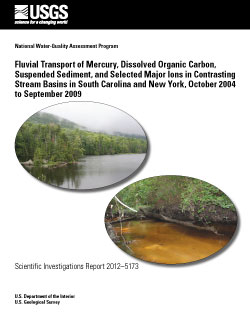Scientific Investigations Report 2012–5173

ABSTRACTA spatially extensive assessment of the environmental controls on mercury transport and bioaccumulation in stream ecosystems in New York and South Carolina was conducted as part of the U.S. Geological Survey National Water-Quality Assessment Program and included the determination of fluvial transport of mercury and associated constituents during water years 2005–2009. (A water year extends from October of one calendar year to September of the next calendar year.) In the Coastal Plain region of South Carolina, the study area included the Edisto River and its headwater tributary, McTier Creek. In the Adirondack region of New York, the study area included the upper Hudson River and its headwater tributary, Fishing Brook. Median concentrations of filtered total mercury rangedfrom 1.55 nanograms per liter (ng/L) at the Hudson River site to 2.77 ng/L at the Edisto River site. The Edisto River site had the greatest median filtered methylmercury concentration, at 0.32 ng/L, and the Hudson River site had the least median filtered methylmercury concentration, at 0.07 ng/L. Two-year (2008 and 2009) mean annual filtered methylmercury yield at the McTier Creek site of 0.025 microgram per square meter per year [(µg/m2)/yr] was almost 3 times less than the filtered methylmercury yield of 0.064 (µg/m2)/yr at the Edisto River site, indicative of increased contributions with increasing scale from headwater stream catchment to larger river basin. Two-year mean yields of filtered total mercury were 0.83 and 0.68 (µg/m2)/yr at the McTier and Edisto sites, respectively, indicative of negligible change in contribution from headwater stream to larger river scale. Yields of particulate forms of mercury were relatively consistent between headwater stream and larger river basin scales. Two-year mean annual yields of particulate methylmercury were 0.009 and 0.011 (µg/m2)/yr at the McTier Creek and Edisto River sites, respectively. Annual particulate total mercury yields were 0.34 (µg/m2)/yr at the McTier Creek site and 0.27 (µg/m2)/yr at the Edisto River site. In contrast to the South Carolina sites, the 2-year mean filtered methylmercury yield of 0.095 (µg/m2)/yr at the Fishing Brook site in New York was higher than the filtered methylmercury yield of 0.068 (µg/m2)/yr at the Hudson River site, indicating decreased contributions with increasing scale from headwater stream catchment to larger river basin. As observed with the South Carolina sites, the 2-year mean yields of filtered total mercury indicated no change in contribution from headwater stream to larger river scale and were 1.67 and 1.66 (µg/m2)/yr at the Fishing Brook and Hudson sites, respectively. Mean annual dissolved organic carbon yields of 24.4 and 16.7 kilograms per hectare per year at the McTier Creek and Edisto River paired basin sites, respectively, were lower than the mean annual dissolved organic carbon yields of 54.4 and 52.9 kilograms per hectare per year at the Fishing Brook and Hudson River paired basin sites, respectively. In South Carolina, mean annual dissolved chloride yields increased slightly with basin scale. Conversely, in New York, mean annual dissolved chloride yields decreased slightly with basin scale; however, basin-scale changes in mean annual dissolved sulfate yields were more consistent between the two paired basins and indicated increasing yields with increasing basin scales. Mean annual suspended sediment yields did not exhibit a consistent pattern between the New York and South Carolina basins or between paired (headwater-large river) sites. In the McTier Creek headwater stream basin, mean annual wet deposition of total mercury was 9.91 (µg/m2)/yr for water years 2005 through 2009. In 2007, litterfall accounted for an estimated 12.8 (µg/m2)/yr of total mercury in this basin. Based on the 2007 estimates, wet deposition of total mercury represented only 37 percent of the total mercury deposition in the McTier Creek basin, and only 7 percent of the total mercury deposition in the McTier Creek basin reached the stream site, indicating storage of the atmospherically derived total mercury within the basin. Mean annual wet deposition of total mercury was 6.30 (µg/m2)/yr for water years 2005 through 2009 in the Fishing Brook basin. Litterfall accounted for an estimated 9.00 (µg/m2)/yr of total mercury in this basin in 2007, which produced a total mercury deposition of 15.4 (µg/m2)/yr. Based on the 2007 estimates, wet deposition of total mercury represented only 42 percent of the total mercury deposition in the Fishing Brook basin. In 2007, only 13 percent of the total mercury deposition in the Fishing Brook basin reached the stream site, indicating storage of the atmospherically derived total mercury within the basin. |
First posted September 26, 2012
For additional information contact: Part or all of this report is presented in Portable Document Format (PDF); the latest version of Adobe Reader or similar software is required to view it. Download the latest version of Adobe Reader, free of charge. |
Journey, C.A., Burns, D.A., Riva-Murray, Karen, Brigham, M.E., Button, D.T., Feaster, T.D., Petkewich, M.D., and Bradley, P.M., 2012, Fluvial transport of mercury, organic carbon, suspended sediment, and selected major ions in contrasting stream basins in South Carolina and New York, October 2004 to September 2009: U.S. Geological Survey Scientific Investigations Report 2012–5173, 125 p.
Foreword
Abstract
Introduction
Previous Investigations
Purpose and Scope
Study Area Description
Edisto River Basin
Upper Hudson River Basin
Data Collection Methods
Streamflow Data Collection
Water-Quality Data Collection
Data Analysis Methods
Land Use and Land Cover
Streamflow Characteristics
Chemical Characteristics
Comparison Among Sites
Load Estimation
Litterfall Estimation
Quality-Assurance and Quality-Control Data
Fluvial Transport of Selected Constituents
Streamflow Characteristics
Chemical Characteristics of the Study Sites
Relation of Streamflow to Mercury Species, Dissolved Organic Carbon, and Suspended Sediment
Estimated Annual Mercury Loads and Yields
Comparison of Stream Yields to Atmospheric Deposition
Summary
References
Appendixes